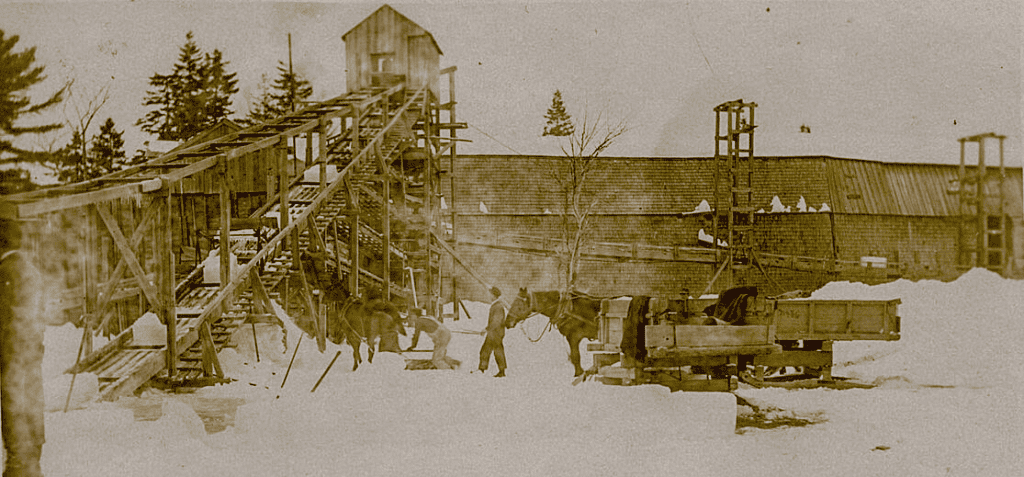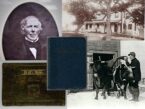
Winter is the season friends and neighbors reconnect, as they have in towns surrounding Acadia National Park for 100 years and more. Explore our winter world—from snowball fights to fancy dress balls. Watch home movies, listen to stories, and browse maps and photos.
“Ours Again” showcases items from the digital collections of the 14 History Trust member organizations plus two local libraries. The exhibit is best viewed in Chrome or Edge browsers.
We are an alliance sharing digital collections through this History Trust online exhibit. Sit back, glimpse memories of . . .
- Ice & Snow – Playful delight and quiet beauty could be found in winter landscapes that altered the routines of daily life.
- Busy Hands – When sea smoke rose and ice thickened, hands stayed warm and busy with indoor projects.
- Winter Work – Work in winter was shaped by cold temperatures and dramatic weather.
- Gathering Together – Neighbors reconnected at winter gatherings.
Remembering Ice Ponds
Where was ice was harvested near you?
Until the mid-1900s blocks of ice kept household food chilled and crushed ice kept fish on boats fresh. Local villages had their own ice ponds. Cutting ice, hauling it, and stacking it in sawdust-filled icehouses gave people work through the coldest time of year. On hot summer days an ice-cold drink would be a reminder of the winter just passed.

We dove into the collections of History Trust members to bring you memories of ice harvesting. For example, the image above shows the F.W. Brewer Ice Company operation on Eagle Lake, which began in 1875.
Winters are Changing
How much winter snow do you remember?
If you remember more than you’ve seen in the last few years, you’ve noticed a trend here in the Northeast. Over the past 100 years we’ve been losing the cold (18 fewer freezing nights) and losing snow (21 fewer days of snow cover).
Thanks!
Exhibit funding provided by the Maine Humanities Council and the National Endowment for the Humanities (NEH) as part of the American Rescue Plan Act of 2021 (mainehumanities.org ).
The exhibit is hosted by College of the Atlantic GIS Lab on the StoryMap digital platform. Gordon Longsworth generously provided his GIS expertise and technical support, pro bono.
Key personnel for developing the online exhibit were:
- Bruce Jacobson, interpretive planner/project manager – EdM in Human Resource Education, Boston University School of Education; BS in Natural Resource Conservation, University of Montana School of Forestry. Certified Interpretive Planner.
- Karen, writer/designer – BA in English and Classical Studies, Wesleyan University; studies in Old English and Old Norse at McGill University and University of Reykjavik.
- Jane Crosen, copy editor – studies in Art History at Brown University and Richmond College (London).
- Julia Gray, consulting anthropologist – MA in Anthropology, University of Arkansas; AB in Anthropology, Bowdoin College; studies in Archaeology and Anthropology, University of Edinburgh.
- Addie Beal, StoryMap technician – studies in Human Ecology and geographic information (GIS) systems, College of the Atlantic.
- Jenna Jendreau, writing assistant – BA in English, University of Maine at Fort Kent and experience staffing several local historical societies.
- Contributing organizations’ volunteers and staff.
- Bar Harbor Historical Society (barharborhistorical.org )
- Bar Harbor Village Improvement Association (barharborvia.org )
- College of the Atlantic (coa.edu )
- Gouldsboro Historical Society (gouldsborohistory.org )
- Great Cranberry Island Historical Society (gcihs.org )
- Great Harbor Maritime Museum (facebook.com/greatharbormaritimemuseum )
- Islesford Historical Society (islesfordhistory.org )
- The Jesup Memorial Library (jesuplibrary.org )
- Maine Seacoast Mission (seacoastmission.org )
- Mount Desert Island Historical Society (mdihistory.org )
- Northeast Library (nehlibrary.org )
- Seal Cove Auto Museum (sealcoveautomuseum.org )
- Southwest Harbor Historical Society (swhhs.org )
- Southwest Harbor Public Library (swhplibrary.org )
- Tremont Historical Society (tremontmainehistory.us )
- William Otis Sawtelle Collections and Research Center, Acadia National Park, National Park Service (nps.gov/acad/learn/historyculture/collections.htm ).
- Visit Us – Visit the archives and museums that contributed to “Ours Again”—Remembering Winter, 1920-2020.
~ Header Image: “Bud [Pearl] Bordeaux on a snowmobile,” Mount Desert Island Historical Society, …view item


